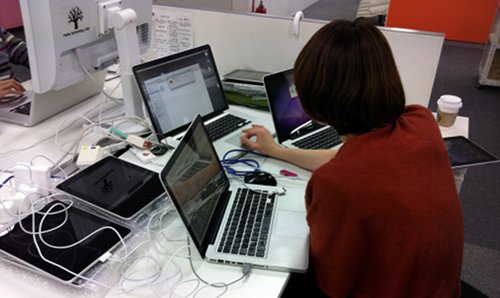Is 'bring your own device' good for business?
Is 'bring your own device' good for business?

Does anyone in your business have this many devices? (Image: kawanet on Flickr.)
As any marketer should, I watch streams of Twitter hashtags and have Google Alerts set up to monitor topics in my business realm.
For nivio, this means I keep a close eye on #DAAS (desktops as a service) #SMB (small-medium business), #VDI (virtual desktop infrastructure) and #BYOD (bring your own device), among others.
Of these feeds, bring your own device is by far the most interesting. Though the concept isn't new - I've been using my personal devices for work in some form for more than a decade - BYOD as a business problem is receiving a lot of media coverage. And, as with most new tech challenges, the coverage is divided on whether BYOD's cost-savings and access benefits really outweigh the security risks.
Your staff want BYOD, and it's happening
Your business is likely already engaging in BYOD. If your staff use personal devices for work, either as their primary system or when they work remotely via laptop, tablet, or smartp hone, your business, too, is part of the BYOD trend. And, you're far from alone: according to a Spiceworks survey (PDF link) more than 75% of small businesses are actively managing personal devices as part of their IT strategy.
But what do small and new business really need to know about BYOD?
Most businesses already support BYOD in the workplace, and if you don't, the chances are your staff are accessing information and files remotely on personal devices anyway.
Having policies in place to limit remote access could be a deterrent and reduce the risks your business faces. However, these require additional IT infrastructure to enforce.
Plus, employees want remote access for flexibility in when, where, and how they work. They want to get information while on the go. And they don't want to juggle a company smart phone and tablet along with their own personal devices.
If not managed properly, BYOD is a security risk
Data security, especially for law, health, and accounting firms, is crucial. Your business needs to ensure information is secure and that you aren't exposed to undue risks by allowing remote access.
You need to integrate employees' own devices into your existing systems, and give your staff support to troubleshoot problems when they occur.
Making BYOD secure
Generally, you have two options for mobile security;
- Mobile device management systems can handle security at individual device level. These are a good fit if your business already has significant in-house IT infrastructure.
- Comprehensive IT management platforms can manage security across all the platforms and devices in your business - including devices owned by your staff.
Is there really a cost saving?
Every business is different, but many companies can see significant cost savings from BYOD.
You'll almost certainly save on hardware costs, and many companies will also save on the software and maintenance costs that go along with running a fleet of devices.
- Trends, risks and benefits of BYOD
- You can't avoid bringing your own device
- The advantages of giving staff more IT choice
Lara Franklin manages content and marketing for nivio, a cloud-based platform providing comprehensive IT infrastructure enabling BYOD and anywhere access for businesses.




Comments
Add a comment